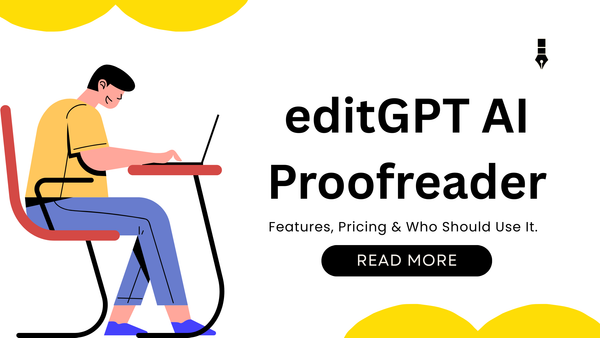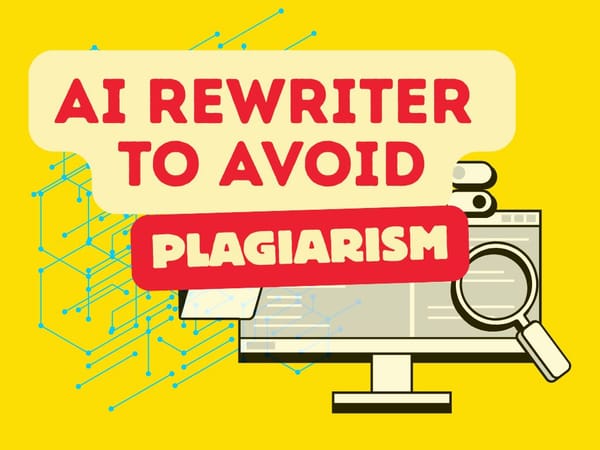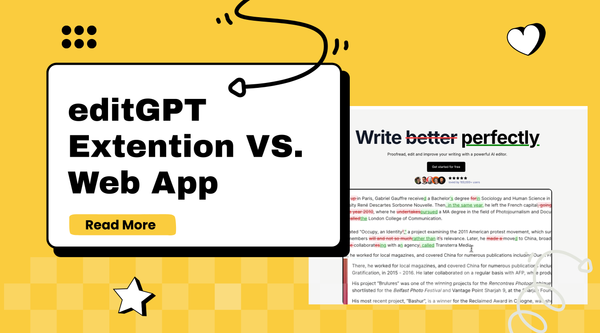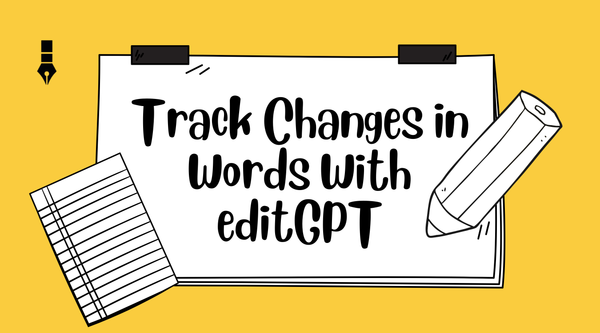Wordtune vs editGPT: What’s Better for Editing Your Work?
Wordtune sentence rewriter vs editGPT: Compare features, use cases, and strengths to find the best AI proofreader for your 2025 writing needs.

Introduction
The two products we are reviewing today are:
Wordtune has been making quite a wave with its smart sentence rewrites and style options, offering quick fixes in just a few clicks and in a clean interface at that. Meanwhile, editGPT edits with the eye of a human. Correcting grammar and structure, offering rewrites, and explaining why.
Here’s the real question.
Are you looking for a tool that helps you rephrase with ease, or one that takes a deeper dive to enhance the flow and clarity while polishing your entire piece?
Most writers only need one go-to tool (and some can only afford to invest in one!), something they can rely on for every draft, deadline, and rewrite.
That’s exactly why we spent months using editGPT and Wordtune side by side, rewriting, proofreading, and pushing these AI tools to their limits, to see which one really delivers for your unique writing needs.
What’s the best sentence rewriter? Let’s compare
editGPT AI Proofreader: More than just an AI proofreader
There’s one thing editGPT does that most AI proofreaders simply can’t: it edits with context, intelligence, and intent.
It goes beyond the surface, instead of just offering surface-level edits and instant suggestions.
No robotic rewrites. No predictable cookie-cutter suggestions. It feels less like a tool and more like a real editor sitting beside you.
It not only improves your content but also explains why certain changes are made, so you’re learning and growing with every edit.
It’s like your second brain. It didn’t even feel like AI when I was using it.
It also supports:
- Tracked changes (just like in Microsoft Word or Google Docs)
- Tone preservation so your voice and your piece’s personality don’t get flattened
- Custom industry prompts such as legal, medical, academic, business, and more
- Multi-lingual support (20+ languages)
Interface and user experience
If you’ve ever used ChatGPT or Microsoft Word, you’ll feel right at home with editGPT.
It’s clean, spacious, and intuitive. My first thought when I first used it was that it felt like it was designed for real writers.
The editing panel? Very well-organized.
The writing suggestions? They keep your original tone and intent intact while staying clear and unobtrusive on your screen.
editGPT can be used both as a Chrome extension and as an integration.
But despite its powerful features…
…editGPT doesn’t feel complicated at all, even when my 11-year-old nephew had to use mine for a school paper. He got into using it right on the spot.
It sure does provide explanations for edits so you understand what’s being changed and why. But it’s surprisingly user-friendly and intuitive.
It’ll feel natural, no technical know-how required.
Editing and proofreading capabilities
This is where editGPT clearly pulls ahead. It’s not like your usual grammar and spell checker. It’s very intelligent and it’ll act like your real human editing assistant (and even better).
Aside from grammatical mistakes, it’ll also catch awkward phrasing (unlike most AI rewriters that only make your content sound even more awkward!), as well as punctuation issues, and even deeper problems such as tone mismatch and vague structure.
But do you know what its strength is?
editGPT’s strength lies in its contextual editing.
While most AI proofreaders and editors only point out grammar and spelling mistakes, editGPT tracks those changes like a human editor would. It’ll also tell you the best option and why.
editGPT can also handle:
- Long-form documents without slowing down and decreasing output quality
- Formatting-sensitive content (bolds, italics, headings, etc)
- Edits with specific tones (academic, legal, marketing, etc)
Rewriting capabilities
One thing about editGPT is that it’ll always feel natural and always be aligned with your tone and your content’s personality and voice. It’ll consider your target audience and writing goal before giving you a rewritten output that reads like it’s from your own mind.
You can also use custom prompts like “Make this more persuasive” or “Edit in an academic tone,” which gives you flexible control over how your content is rewritten.
How does Wordtune editor compare?
We love Wordtune for delivering a frictionless experience.
It’s built for speed and simplicity. Wordtune is a sentence rewriter tool known for its easy rephrasing capabilities that shift awkward lines or tones on the fly.
Wordtune can:
- Polish a sentence that you’ll paste into it, and give you suggestions for clarity, formality, and conciseness
- Switch between casual, formal, and neutral tones depending on your content’s intent
- Make sentences more elaborate or more condensed in just one click
Interface and user experience
Wordtune is light and clickable. It’s uncluttered and clean.
It’s because Wordtune is built for speed and casual users. Just paste a sentence and its rewrite suggestions will instantly appear in a pop-up format.
It’s perfect for you if you want a fast and easy result without too many features getting in the way.
It almost has no learning curve.
This is because there’s nothing to learn. It’s designed to be plug-and-play. You highlight a sentence, get a few options, and choose what fits your vision.
Of course, it comes at a cost.
It’s so simple that you won’t get much guidance on why one option might be better than the other, or how to improve the overall structure.
Editing and proofreading capabilities
If you’re aiming to just improve or rewrite sentences, then Wordtune will be your best bet.
But it’s not the best for long-form content.
Wordtune doesn’t offer proofreading. It doesn’t even catch grammatical errors or offer tracked suggestions. It’s only focused on rewriting sentences and not polishing your entire draft.
Rewriting capabilities
Rewriting is Wordtune’s bread and butter. Simply said, it’s best at generating quick versions of a sentence.
Want a sentence condensed? Expanded? Formal? More casual? Wordtune delivered instantly.
The catch?
It doesn’t understand context beyond the sentence, like editGPT does. That explains why it often gave me suggestions that didn’t match the entire paragraph or message I pasted.
editGPT vs Wordtune
No option is wrong if it fits your writing needs.
What’s wrong is investing in something that won’t actually give you the results you need for a smoother and easier workflow.
If you just need a fast and reliable sentence rewriter, Wordtune could be good for you. But it only offers 10 rewriters per day and 3 AI summaries per month for the free version.
And with its not-so-competitive price of $9.99 per month annually, I don’t find it very worthwhile to spend that much just for a sentence rewriter. I’d just keep on using the free version, as I could always use other tools that can do the same, instead.
How about editGPT?
editGPT offers $12 and $25 monthly plans that include a suite of powerful features such as longform editing mode, batch editing, multi-language detection, custom prompts, industry-specific mode, importing and exporting to Word and Docs, and new features every week.
The thing is…
…editGPT can be whatever you need it to be. If you need some quick proofreading, its easy-to-use grammar checker will provide you with corrections and suggestions in a way that’s not intimidating or overwhelming. Just straightforward and fluff-free.
It can also be in-depth and complex if you need something powerful to rewrite thesis, research papers, case studies, and other long-form documents.
The best thing about editGPT is that it goes deep for you. It’ll show you how the result happened, so you’re growing while editing.
It’s intelligent in a way that is almost flabbergasting, as it feels like a real human. It understands your tone and intent and will proofread and edit around that, so the result it will give is cohesive with your own written content.
Having editGPT seriously saved me from having to buy more tools for different purposes. It’s not so pricey (but not too cheap, too) and still, it’s built like a writer’s Swiss knife with all its powerful features and integrations.
Conclusion
When choosing between two AI proofreading tools, it’s important to remember that it’s not just about what looks helpful on the surface, but what you get in the long run.
If I’m going to invest my money in an AI proofreading tool, I want something that doesn’t just make my work cleaner, but makes me better as a writer, as a communicator, and in my career.
We loved how Wordtune delivered quick fixes for us every time.
But surface-level edits are very easy to come by these days, especially among free tools. That makes the smarter editors stand out.
And that’s where editGPT shines.
It not only polishes your words, but also understands them, strengthens them, and teaches you why.
And with a more accessible price point than most heavy-duty AI tools? Now, that’s real value.
Video review: This AI Text Editing Tool Is FLAWLESS!
Recommended Reading
- Video review: This AI Text Editing Tool Is FLAWLESS!
- Best AI Proofreader Tools of 2025 (Tested for Accuracy, Speed & Tone)
- editGPT vs Grammarly vs Quillbot: Which Writing Tool is Best?
- The Best AI Proofreaders That Actually Work (Free & Paid)
- Try editGPT
- Review: Wordtune Editor vs editGPT
- Review: Grammarly vs editGPT
- Review: ProWritingAid vs editGPT
- Review: Hemingway Editor vs editGPT
- Review: editGPT vs Trinka AI: Which is the best Grammarly alternative?
- Best AI Tools for College Essay Editing in 2025
- What is the best AI Proofreader?
- Best AI Proofreader Tools of 2025 (Tested for Accuracy, Speed & Tone)



